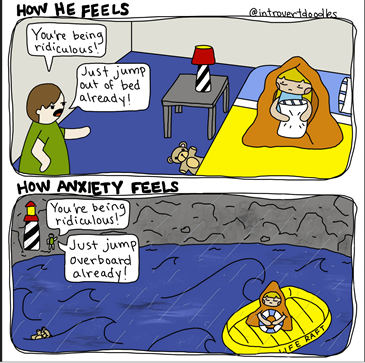Agoraphobia
Advanced Therapeutic Solutions for Anxiety provides therapy for the treatment of Agoraphobia.
Many people misunderstand what agoraphobia is, thinking it’s a fear of leaving the house. Actually, it’s a fear of not being able to escape. If panic symptoms or other incapacitating or embarrassing symptoms (e.g., vomiting, soiling oneself, falling) should arise, how can they escape if they are:
- On public transportation (“can’t get off”)
- In open spaces (“can’t find anyone to help”)
- In enclosed spaces (“can’t get out”)
- In line or in a crowd (“can’t get out”)
- Outside of the home alone (“can’t find anyone to help”)
The fear that something terrible might happen is out of proportion to the actual danger posed. The fear of not being able to escape the situation or that escape may be difficult leads an individual with agoraphobia to play it safe by staying home. Another safety behavior may be only going out if someone goes with them, just in case, because then that person can help them escape a situation in case panic arises. If the individual with agoraphobia can’t avoid the situation or can’t have a companion with them, then the situation is endured with intense fear or anxiety.
Agoraphobia peaks in late adolescents and early adulthood, affecting 1.7% (1 of 58) of adolescents and adults. For individuals over 65, the prevalence decreases to .4%. Up to half of individuals with agoraphobia have had a panic attack preceding the onset of agoraphobia. There are two incidence risk phases: late adolescence/early adulthood and again after age 40. Mean age of onset is 17 years old for those who have had panic attacks before developing agoraphobia, and 25-29 years old for those who have no had preceding panic attacks or panic disorder.
Left untreated, the avoidance can become so severe that it can lead the individual to be completely housebound. Complete recovery without treatment is rare (10%). Treatment for agoraphobia includes cognitive behavioral therapy to address the cognitions that feed the fear, as well as determining what avoidance or safety behaviors are being used that prevent the individual from learning that their fear is inaccurate. Exposure therapy is used to target the situations that are feared. Instead of “white-knuckling” through it, or distracting oneself during it, the therapist helps the individual focus on the situation and reducing the safety behaviors in the moment.
Clinical Procedures for Agoraphobia Evaluation and Outpatient Treatment
Free Phone Intake Consultation
Up to 30-min phone consultation so we can hear about your presenting issue, the symptoms you are experiencing, when they started, the severity of symptoms, and if we are the appropriate place for your treatment. The diagnostic intake process is discussed, and your insurance/billing questions are answered. If the treatment you need is within our scope of services, we begin the scheduling process. If it is deemed that we are not the appropriate place, we will provide you with referrals and resources to help you. We want to make sure to connect you with services, and that includes helping you find treatment elsewhere if that's what you need.
Free
CPT CODE: 0
Diagnostic Evaluation
A 90-min diagnostic interview is conducted to assess the presenting problem, symptoms severity (onset, duration, frequency), review areas of life that have been impacted (daily functioning, work, home), collect history, including family history of anxiety or depression, and review what you hope to gain from treatment at ATSA. Specific questions and or measures may be administered during the session for diagnostic purposes.
Starting at 295
CPT CODE: 90791
Treatment Planning Session
A 60-min session to review how the first sessions have felt to you, present hypotheses, and collaborate on a treatment plan. Treatment approaches may include Acceptance and Commitment Therapy (ACT), Cognitive Behavioral Therapy (CBT), Exposure and Response Prevention (ERP). Treatment dose is also discussed, specifically if weekly 60-min outpatient sessions will be effective, or if intensive doses (e.g., 3-hr sessions) should be considered. Likewise, location of where sessions should occur for most effective outcome is also discussed and planned out. Decisions are made as to whether to start with therapy sessions only, allowing for the future addition of psychopharmacological treatment as an adjunct, or whether to start with combined treatment, (or in rare cases to start with psychopharmacological treatment before CBT, ACT, or ERP).
Starting at 175
CPT CODE: 90837
Exposure Clinic Session
60 min exposure sessions to present you with the phobic stimulus and begin the process of fear extinction. The key to exposure therapy is to activate new learning, which is done by presenting the phobic stimulus, and assisting you to approach (vs avoid) the stimulus, using a hierarchical approach. With repeated exposures, you gain distress tolerance and fear extinction. Additional therapies (e.g., ACT, CBT) may be applied to keep you focused and motivated in preparation for exposures, particularly when exposures become more challenging as we move up the hierarchy. When possible, family members will be included to learn how to facilitate approach coping and reduce enabling avoidance. Our data show that when family members learn how to support you, you are more likely to maintain your treatment gains.
Starting at 175
CPT CODE: 90837
Exposure Therapy in Home or Community Settings
60-min exposure sessions provided in the home or community setting to help transfer treatment gains into these domains. To increase transfer of treatment gains, reduce avoidance of the phobia across settings, and reduce others rescuing you from approaching your phobia (to rescue you from distress), in-vivo and in-situ exposure therapy is most effective. Not only will you develop distress tolerance, new learning, and fear extinction, so will others in these settings, which helps them reduce rescuing and enabling. Home visits are used to help you use skills at home, and Community sessions provide exposure practice in new settings.
Starting at 185 + travel
CPT CODE: 90837
